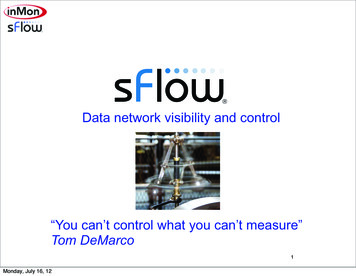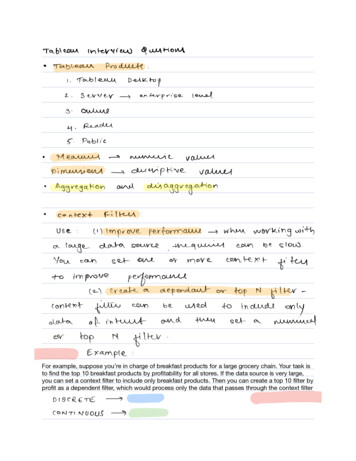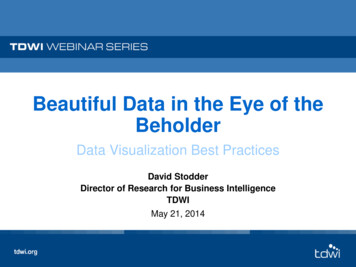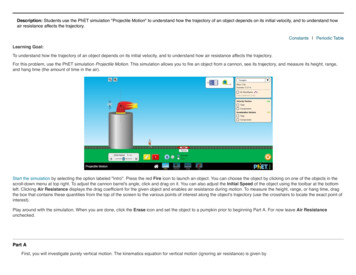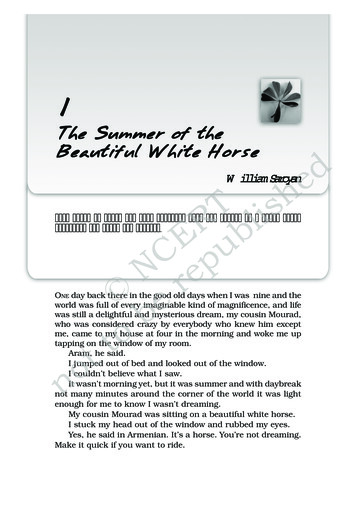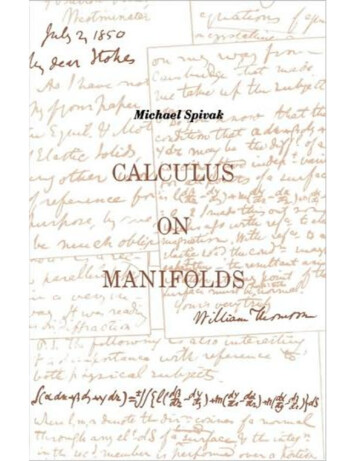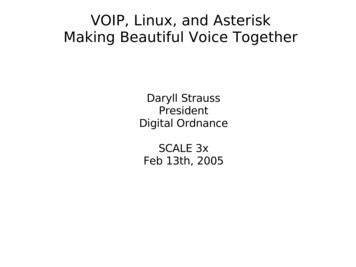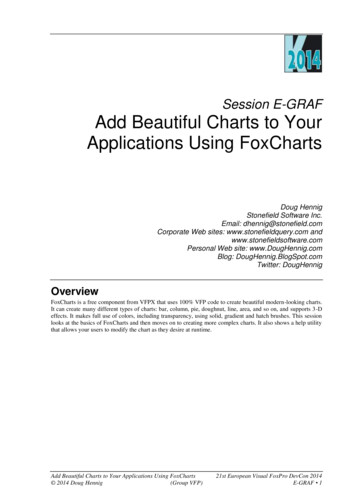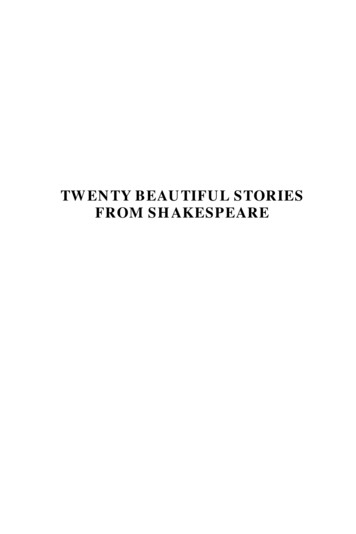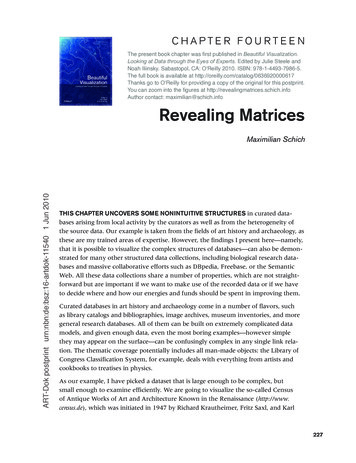
Transcription
Chapter FourteenThe present book chapter was first published in Beautiful Visualization.Looking at Data through the Eyes of Experts. Edited by Julie Steele andNoah Iliinsky. Sabastopol, CA: O‘Reilly 2010. ISBN: 978-1-4493-7986-5.The full book is available at http://oreilly.com/catalog/0636920000617Thanks go to O‘Reilly for providing a copy of the original for this postprint.You can zoom into the figures at http://revealingmatrices.schich.infoAuthor contact: maximilian@schich.infoRevealing MatricesART-Dok postprint urn:nbn:de:bsz:16-artdok-11540 1 Jun 2010Maximilian SchichThis chapter uncovers some nonintuitive structures in curated databases arising from local activity by the curators as well as from the heterogeneity ofthe source data. Our example is taken from the fields of art history and archaeology, asthese are my trained areas of expertise. However, the findings I present here—namely,that it is possible to visualize the complex structures of databases—can also be demonstrated for many other structured data collections, including biological research databases and massive collaborative efforts such as DBpedia, Freebase, or the SemanticWeb. All these data collections share a number of properties, which are not straightforward but are important if we want to make use of the recorded data or if we haveto decide where and how our energies and funds should be spent in improving them.Curated databases in art history and archaeology come in a number of flavors, suchas library catalogs and bibliographies, image archives, museum inventories, and moregeneral research databases. All of them can be built on extremely complicated datamodels, and given enough data, even the most boring examples—however simplethey may appear on the surface—can be confusingly complex in any single link relation. The thematic coverage potentially includes all man-made objects: the Library ofCongress Classification System, for example, deals with everything from artists andcookbooks to treatises in physics.As our example, I have picked a dataset that is large enough to be complex, butsmall enough to examine efficiently. We are going to visualize the so-called Censusof Antique Works of Art and Architecture Known in the Renaissance (http://www.census.de), which was initiated in 1947 by Richard Krautheimer, Fritz Saxl, and Karl227
Lehmann-Hartleben. The CENSUS collects information about ancient monuments—such as Roman sculptures and architecture—appearing in Western Renaissance documents such as sketchbooks, drawings, and guidebooks. We will look at the state ofthe database at the point just before it was transferred from a graph-based databasesystem (CENSUS 2005) to a more traditional relational database format (CENSUSBBAW) in 2006, allowing for comparison of the historic state with current and futureachievements.The More, the Better?Having worked with art research databases for over a decade, one of the most intriguing questions for me has always been how to measure the quality of these projects.Databases in the humanities are rarely cited like scholarly articles, so the usual evaluation criteria for publications do not apply. Instead, evaluations mostly focus on a number of superficial criteria such as the adherence to standards, quality of user interfaces,fancy project titles, and use of recent buzzwords in the project description. Regardingcontent, evaluators are often satisfied with a few basic measures such as looking at thenumber of records in the database and asking a few questions concerning the subtleties of a handful of particular entries.The problem with standard definitions such as the CIDOC Conceptual ReferenceModel (CIDOC-CRM) for data models or the Open Archives Initiative Protocol forMetadata Harvesting (OAI-PMH) for data exchange is that they are usually applied apriori, providing no information about the quality of the data collected and processedwithin their frameworks. The same is true of the user interfaces, which give as muchindication of the quality of the content as does the aspect ratio of a printed sheet ofpaper. Furthermore, both data standards and user interfaces change over time, whichmakes their significance as evaluation criteria even more difficult to judge. As anyprogrammer knows, an algorithm written in the old Fortran language can be just aselegant as and even faster than a modern Python script. As a consequence, we shouldavoid any form of system patriotism in project evaluation—that is, the users of a particular standard should not have to be afraid of being evaluated by the fans of another.Even the application of standards we all consider desirable, such as Open Access, is ofquestionable value: while Open Access provides a positive spin to many current projects, its meaning within the realm of curated databases is not entirely clear. Should wereally be satisfied with a complicated but free user interface (cf. Bartsch 2008, fig. 10),or should we prefer a sophisticated API and periodical dumps of the full database (cf.Freebase), which would allow for serious analysis and more advanced scholarly reuseof the data? And if there is Open Access, who is going to pay the salary of a privateenterprise data curator?Ultimately, we must look at the actual content of any given project. As this chapterwill demonstrate, when evaluating a database it makes only limited sense to focus onthe subtleties of a few particular entries, as usually there is no average information228Beautiful Visualization
against which to measure any particular database entry. The omnipresent phenomenon of long tails (Anderson 2006; Newman 2005; Schich et al. 2009, note 5), whichwe will encounter in almost all the figures in this chapter, suggests that it would beunwise to extrapolate from a few data-rich entries to the whole database—i.e., in theCENSUS, we cannot make inferences about all the other ancient monuments basedsolely on the Pantheon.The most neutral of the commonly applied measures remaining for evaluation is thenumber of records in the database. It is given in almost all project specifications: encyclopedias list the number of articles they contain (cf. Wikipedia); biomedical databasespublish the number of compounds, genes, or proteins they contain (cf. Phosphosite2003–2007 or Flybase 2008); and even search engines traditionally (but ever morereluctantly) provide the number of pages in their indexes (Sullivan 2005). It is therefore no wonder that the CENSUS project also provides some numbers:More than 200.000 entries contain pictorial and written documents, locations, persons, concepts of times and styles, events, research literature and illustrations. Themonuments registered amount to about 6.500, the entries of monuments to about12.000 and the entries of documents to 28.000.*Although these numbers are surely impressive from the point of view of art history,where large exhibition catalogs usually contain a couple of hundred entries, it is easyto disprove the significance of the number of records as a good measure of databasequality, if taken in isolation. Just as search engines struggle with near duplicates (cf.Chakrabarti 2003, p. 71), research databases such as the CENSUS aim to normalizedata by eliminating apparent redundancies arising from uncertainties in the raw dataand the ever-present multiplicity of opinion. Figure 14-1 gives a striking example ofthis phenomenon. Note that the total number of links remains stable before and afterthe normalization, pointing to a more meaningful first approximation of quality, usingthe ratio of the number of links relative to the number of entries: 3/6 vs. 3/4 in thisexample.drawing Adrawing Bdrawing Chercules 1hercules 2hercules 3drawing Adrawing Bdrawing CHercules FarneseNapoli, Museo Archeologico Nazionale, inv. 6001Figure 14-1. Growing dataset quality by shrinking number of recordsClearly, more sophisticated measures are required in order to evaluate the quality ofa given database. If we really want to know the value of a dataset, we have to look atthe global emerging structure, which the commonly used indicators do not reveal. Theonly thing we can expect in any dataset is that the global structure can be characterized as a nontrivial, complex system. The complexity emerges from local activity (Chua2005), as the availability of and attention to the source data are highly hetereogeneous* From http://www.census.de, retrieved 9/14/2009.chapter 14: revealing matrices229
by nature. Furthermore, every curator has a different idea about the a priori datamodel definitions. As the resulting structural complexity is difficult to predict, we haveto measure and visualize it in a meaningful way.Databases As NetworksStructured data in the fields of art history and archaeology, as in any other field, comesin a variety of formats, such as relational or object-oriented databases, spreadsheets,XML documents, and RDF graphs; semistructured data is found in wikis, PDFs, HTMLpages, and (perhaps more than in other fields) on traditional paper. Disregarding thesubtleties of all these representational forms, the underlying technical structure usually involves three areas: A data model convention, ranging from simple index card separators in a woodenbox to complicated ontologies in your favorite representational language Data-formatting rules, including display templates such as lenses (Pietriga et al.2006) or predefined query instructions Data-processing rules that act according to the data-formatting instructionsHere, we are interested first and foremost in how the chosen data model conventioninterrelates with the available data.As Toby Segaran (2009) pointed out in Beautiful Data, there are two ends of the spectrum regarding data model conventions. On one end, the database is amended withnew tables, new fields in existing tables, new indices, and new connections betweentables each time a new kind of information is taken into consideration, complicatingthe database model ever further. On the other end, one can build a very basic schema(as shown in Figure 14-2) that can support any type of data, essentially representingthe data as a graph instead of a set of urceNodeIDTargetNodeIDLinkTypeFigure 14-2. Databases can be mapped to a basic schema of nodes and edgesRepresented in this form, every database can be considered a network. Databaseentries form the nodes of the network, and database relations figure as the connections between the nodes (the so-called edges or links). If we consider art researchdatabases as networks, a large number of possible node types emerge: the nodes canbe the entries representing physical objects such as Monuments and Documents, aswell as Persons, Locations, Dates, or Events (cf. Saxl 1947). Any relation between two230Beautiful Visualization
nodes—such as “Drawing A was created by Person B”—is a link or edge. Thus, thereare a large number of possible link types, based on the relations between the variousnode types.A priori definitions of node and link types in the network correspond to traditional datamodel conventions, allowing for the collection of a large amount of data by a largenumber of curators. In addition, the network representation enables the direct application of computational analytic methods taken from the science of complex networks,allowing for a holistic overview encompassing all available data. As a consequence, wecan uncover hidden structures that go far beyond the state of knowledge at the pointof time when the database was conceptualized and that are undiscoverable by regularlocal queries. This in turn enables us to reach beyond the common measures of qualityin our evaluations: we can check how well the data actually fits the data model convention, whether the applied standards are appropriate, and whether it makes sense toconnect the database with other sources of data.Data Model Definition Plus EmergenceTo get an idea of the basic structure, the first thing we want to see in a database evaluation is the data model—if possible, including some indicators of how the actual datais distributed within the model. If we’re starting from a graph representation of thedatabase, as defined in Figure 14-2, this is a simple task. All we need is a nodeset andan edgeset, which can be easily produced from a relational set of tables; it might evencome for free if the database is available in the form of an RDF dump (Freebase 2009)or as Linked Data (Bizer, Heath, and Berners-Lee 2009). From there, we can easily produce a node-link diagram using a graph drawing program such as Cytoscape (Shannonet al. 2003)—an open source application that has its roots in the biological networksscientific community. The resulting diagram, shown in Figure 14-3, depicts the givendata model in a similar way as a regular Entity-Relationship (E-R) data structure diagram (Chen 1976), enriched with some quantitative information about the actualdata.The CENSUS data model shown in Figure 14-3 is a metanetwork extracted from thegraph database schema according to Figure 14-2: every node type is depicted as ametanode, and every link type is depicted as a metalink connecting two metanodes.The metanode size reflects the number of actual nodes and the metalink line widthcorresponds to the number of actual links, effectively giving us a first idea about thedistribution of data within the database model. Note that both node sizes and link linewidths are highly heterogeneous across types, spanning four to five orders of magnitude in our example. Frequent node and link types occur way more often in realitythan the majority of less frequent types—a fact that is usually not reflected in traditional E-R data structure diagrams, often leading to lengthy discussions about almostirrelevant areas of particular database models.chapter 14: revealing matrices231
ImageypDocumentgrCitationmonapument bib liparallel replicaograplicaReplicaStyleofonatilocenavemonumm o n u m e n
230 Beautiful Visualization by nature. Furthermore, every curator has a different idea about the a priori data model definitions. As the resulting structural complexity is difficult to predict, we have


